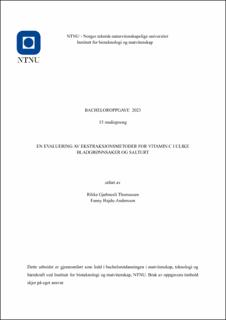| dc.contributor.advisor | Mehli, Lisbeth | |
| dc.contributor.advisor | Thomassen, Gunn Merethe Bjørge | |
| dc.contributor.author | Hajdu-Andersson, Fanny | |
| dc.contributor.author | Thomassen, Rikke | |
| dc.date.accessioned | 2023-06-30T17:21:18Z | |
| dc.date.available | 2023-06-30T17:21:18Z | |
| dc.date.issued | 2023 | |
| dc.identifier | no.ntnu:inspera:140792035:149018788 | |
| dc.identifier.uri | https://hdl.handle.net/11250/3074899 | |
| dc.description.abstract | Hovedmålet med denne oppgaven var å bestemme den mest gunstige ekstraksjonsmetoden for vitamin C i ulike plantematerialer. Dette ble gjort ved å utføre og deretter vurdere ulike ekstraksjonsmetoder.
Det ble tatt utgangspunkt i to ekstraksjonsmetoder, metode A og metode B, med noen tilpasninger. Basert på hvilken forbehandlingsmetode som ble benytte på plantematerialet, ble metodene inndelt i fire ekstraksjonsmetoder: metode A med med frysetørket plantemateriale (AF), metode A med plantemateriale behandlet med flytende nitrogen (AN), metode B med frysetørket plantemateriale (BF) og metode B med plantemateriale behandlet med flytende nitrogen (BN). Ekstraksjon ble utført på tre forskjellige plantematerialer: salat, grønnkål og salturt. Alle ekstrakter ble injisert i et HPLC-instrument for detektering og kvantifisering av vitamin C. Den endelige vurderingen av ekstraksjonsmetodene ble basert på kvantifisert innhold av vitamin C, i tillegg til en evaluering av hvor krevende utførelsen av metodene var.
Ved ekstraksjon fra salat ble det kvantisert høyest innhold av vitamin C ved utførelse av metode AN, men for grønnkål og salturt ble det kvantifisert høyest vitamin C innhold med metode AF. Både metode AF og AN ga signifikant høyere innhold av vitamin C enn metodene BF og BN. Resultatene viste at uavhengig av forbehandlingsmetode, ble det kvantifisert et høyere vitamin C innhold i salat, grønnkål og salturt, ved utførelse av metode A, enn ved utførelse av metode B. Ved evaluering av utførelsen av de fire ekstraksjonsmetodene ble metode AN vurdert som minst krevende. Det ble derfor konkludert med at metode AF og AN, avhengig av type plantemateriale, er de mest gunstige metodene dersom høyest utbytte vektlegges, og at metode AN var den mest gunstigste metoden dersom utførelsen vektlegges. Ved vektlegging av både utførelse og kvantifisering av vitamin C innhold er metode A generelt mer gunstig enn metode B. | |
| dc.description.abstract | The main goal of this task was to determine the most favorable extraction method with respect to vitamin C in various plant materials. This was determined by performing and evaluating various extraction methods.
Two extraction methods were performed, method A and method B, with some adjustments. Based on the pretreatment of the plant material, these methods were divided into four extraction methods: method A with freeze-dried plant material (AF), method A with plant material treated with liquid nitrogen (AN), method B with freeze-dried plant material (BF) and method B with plant material treated with liquid nitrogen (BN). The extractions weree performed on three different plant materials: lettuce, kale and saltwort. All the extracts were injected into an HPLC instrument for detection and quantification of vitamin C. The final assessment of the extraction methods was based on the quantified content of vitamin C, as well as an evaluation of how demanding the performance of the methods were.
When extracting from lettuce, the highest content of vitamin C was quantised using method AN, however for kale and saltwort, the highest vitamin C content was quantified using method AF. Both methods, AF and AN, gave significantly higher content of vitamin C compared to methods BF and BN. The results showed that irrespective of the pre-treatment method, a higher vitamin C content was quantified in lettuce, kale and saltwort when performing method A, compared to method B. When evaluating the performance of the four extraction methods, method AN was considered to be least demanding. Based on this, it was concluded that methods AF and AN, depending on the type of plant material, are the most favourable methods if the highest yield is emphasized, and that method AN is the most favourable method if execution is emphasized. When emphasizing both the execution and quantification of vitamin C content, method A is generally more beneficial than method B. | |
| dc.language | nob | |
| dc.publisher | NTNU | |
| dc.title | En evaluering av ekstraksjonsmetoder for vitamin C i ulike bladgrønnsaker og salturt | |
| dc.type | Bachelor thesis | |
